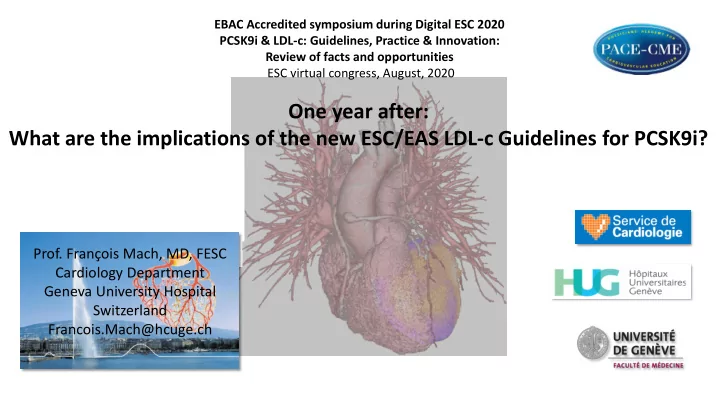

EBAC Accredited symposium during Digital ESC 2020 PCSK9i & LDL-c: Guidelines, Practice & Innovation: Review of facts and opportunities ESC virtual congress, August, 2020 One year after: What are the implications of the new ESC/EAS LDL-c Guidelines for PCSK9i? Prof. François Mach, MD, FESC Cardiology Department Geneva University Hospital Switzerland Francois.Mach@hcuge.ch
No financial conflicts of interest All my honoraria for conferences and advisory board are intended for the GEcor Foundation, which supports cardiovascular research within Geneva University Hospital.
Characteristics of lipoproteins
Time-exposure to low LDL-c Eur Heart J 2017;38:2459
Evidence for efficacy of LDL-lowering therapies Source of evidence Mean reduction in LDL Outcome RR (95% CI) cholesterol; mmol/L [mg/dL] CTT meta-analysis 1 (high-intensity vs standard 1.71 [66] vs 1.32 [50] MI, CHD death, 0.71 (0.56-0.91) statin; subgroup <2.0 mmol/L) stroke, coronary [per mmol/L] revasc. IMPROVE-IT 2 (eze plus statin vs statin) 1.80 [70] vs 1.40 [54] CV death, MI, 0.94 (0.89-0.99) stroke, UA, coronary revasc FOURIER 3 (evolocumab plus high-dose statin ± 2.37 [92] vs 0.78 [30] CV death, MI, 0.85 (0.79-0.92) eze vs high-dose statin ± eze) stroke, UA, coronary revasc ODYSSEYOUTCOMES 4 (alirocumab plus high- 2.37 [92] vs 1.37 [53] MI, CHD death, 0.85 (0.78-0.93) dose statin ± eze vs high-dose statin ± eze) stroke, UA 1. Lancet 2010; 376: 1670-81; 2. NEJM 2015; 372: 2387-97; 3. NEJM 2017; 376: 1713-22; 4. NEJM 2018; 379: 2097-107
PCSK9 mAb: Efficacy and safety Lancet 2017;390:1962
PCSK9 mAb: Efficacy and safety Can J Cardiol 2018;34:1600
Eur Heart J 2020;41:111-188
Concepts for lipid lowering treatment ▪ Define CV risk (very high-risk patients) ▪ Define LDL-C goals and targets ▪ Choose best lipid-lowering strategies
Cardiovascular risk categories (2)
Recommendations for low-density lipoprotein cholesterol lowering (1)
Recommendations for low-density lipoprotein cholesterol lowering (2)
Recommendations for low-density lipoprotein cholesterol lowering (2)
Recommendations for pharmacological low-density lipoprotein cholesterol lowering (3)
Recommendations for lipid-lowering therapy in very-high-risk patients with acute coronary syndromes (1)
Recommendations for lipid-lowering therapy in very-high-risk patients with acute coronary syndromes (2)
Intensity of pharmacological LDL lowering
2016 vs 2019 ESC/EAS Lipid Guidelines 2016 ESC/EAS 1 2019 ESC/EAS 2 Category Recommendation Category Recommendation Very high risk LDL-C goal of <1.8 mmol/L (70 Very high risk LDL-C reduction of ≥50% from CVD mg/dL). Documented ASCVD baseline and an LDL-C goal of <1.4 - - DM with target organ If baseline LDL-C is 1.8 – 3.5 DM with target organ damage. ≥3 major mmol/L (55 md/dL) - - damage mmol/L (70 and 135 mg/dL) a risk factors or early onset of T1DM of Severe CKD (GFR <30 reduction of ≥50% should also >20 years. - mL/min/1.73 m 2 be achieved. SCORE ≥10% for 10 -year risk of fatal CV. - FH with ASCVD or with another major - risk factor. Severe CKD (GFR <30 mL/min/1.73 m 2 High Risk LDL-C goal of <2.6 mmol/L (100 - Markedly elevated singe mg/dL). At least a 50% - risk factors, in particular reduction from baseline, if >2.6 cholesterol >8 mmol/L mmol/L (100 mg/dL) should also High Risk LDL-C reduction of ≥50% from (>310 mg/dL) (e.g. FH) or be achieved. Markedly elevated singe risk factors, in baseline and an LDL-C goal of <1.8 - BP ≥180/110 mmHg. particular total cholesterol >8 mmol/L mmol/L (70 md/dL) Most other people with (>310 mg/dL), LDL-C >4.9 mmol/L (>190 - DM mg/dL),or BP ≥180/110 mmHg. Moderate CKD (GFR 30-59 Patients with FH without other major - - mL/min/1.73 m 2 risk factors. A calculated SCORE ≥5% DM without target organ damage, with - - and <10% for 10-year risk DM duration >10 years or other of fatal CVD. additional risk factors. Moderate CKD (GFR 30-59 mL/min/1.73 - m 2 SCORE ≥5% and <10% for 10 -year risk of - fatal CVD. 1. Eur Heart J 2016;37:2999-3058 2. Eur Heart J 2020;41:111-188
Opportunities and challenges for the future Efficacy of different approaches to lipid lowering Nature Rev Cardiol 2018;15:261
The modern concept of lipid-lowering strategies to reduce cardiovascular diseases Concept change I: Start Early Less “lipid - exposure” leads to prevention of lesion formation Concept change II: Treat (much more) aggressively From desirable target to “LDL - C elimination in the blood” Concept change III: Use combination therapy Statin + Ezetimibe (+/- PCSK9mAb) induced LDL-C lowering reduces CV-risk
Recommend
More recommend